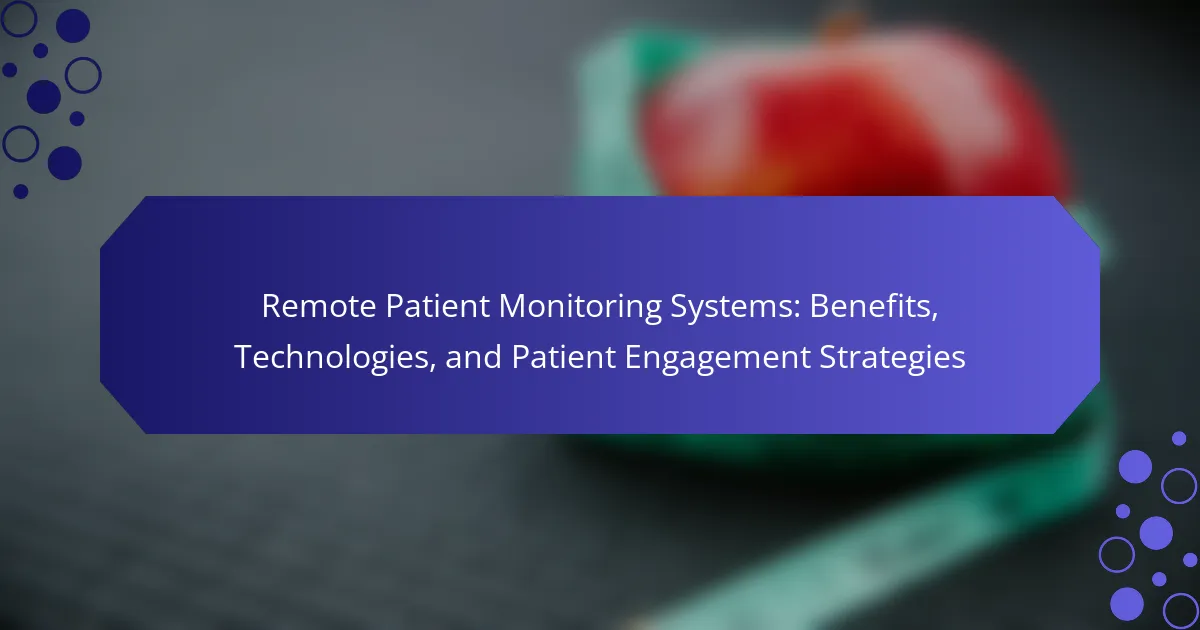Remote Patient Monitoring Systems enhance patient engagement and improve health outcomes by enabling continuous health data collection. This article explores the technologies involved, such as wearable devices and telehealth platforms, and discusses effective patient engagement strategies. Additionally, it addresses the challenges healthcare providers face in implementing these systems and highlights key differentiators that optimize patient care.
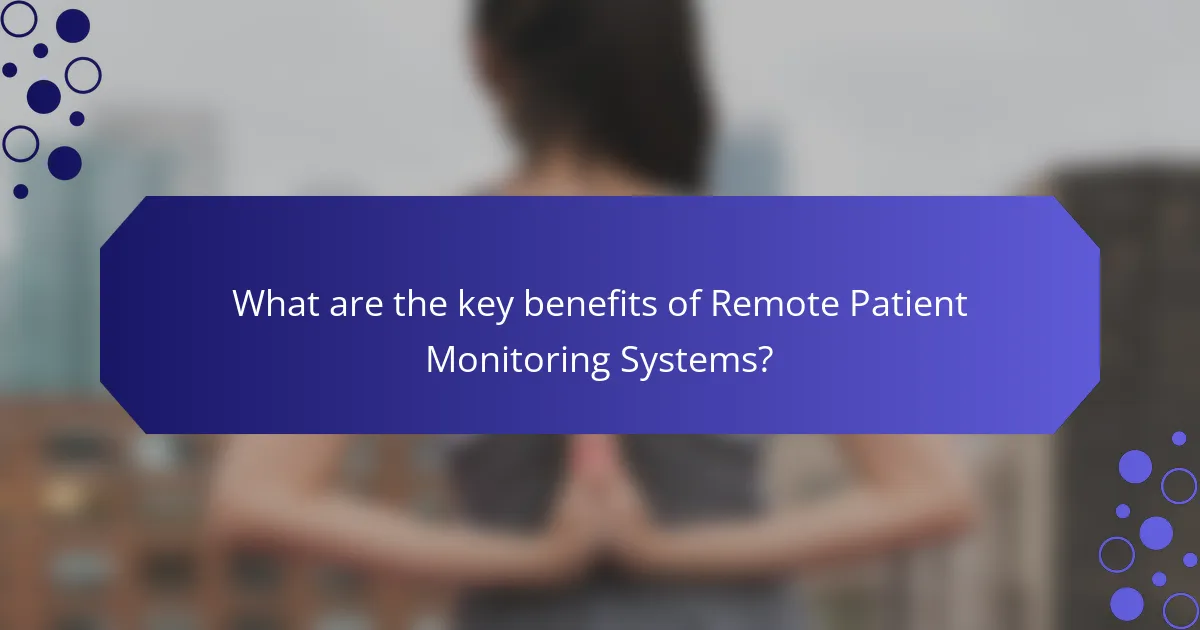
What are the key benefits of Remote Patient Monitoring Systems?
Remote Patient Monitoring Systems offer numerous benefits, including enhanced patient engagement and improved health outcomes. These systems enable continuous health data collection, allowing for timely interventions. They reduce hospital readmissions and healthcare costs by facilitating proactive care management. Additionally, they empower patients with real-time access to their health information, fostering better adherence to treatment plans.
How do Remote Patient Monitoring Systems enhance patient outcomes?
Remote Patient Monitoring Systems significantly enhance patient outcomes by providing continuous health data, enabling timely interventions. These systems utilize technologies such as wearable devices and mobile applications to track vital signs and chronic conditions. As a result, patients experience improved adherence to treatment plans and reduced hospital readmissions. Engaging patients through real-time feedback fosters a proactive approach to health management, ultimately leading to better health outcomes.
What cost savings can healthcare providers achieve with Remote Patient Monitoring?
Healthcare providers can achieve significant cost savings with Remote Patient Monitoring by reducing hospital readmissions, minimizing in-person visits, and improving chronic disease management. A study found that RPM can lower healthcare costs by up to 30% through enhanced patient engagement and proactive care. This technology allows for continuous monitoring, which can lead to timely interventions and better health outcomes. As a result, providers can allocate resources more efficiently and reduce operational costs associated with traditional care models.
Which patient demographics benefit the most from Remote Patient Monitoring?
Older adults, patients with chronic conditions, and those in remote areas benefit most from Remote Patient Monitoring. These demographics experience improved health outcomes, enhanced engagement, and reduced hospital visits. For instance, older adults often require consistent monitoring, making these systems vital for timely interventions. Chronic condition patients gain regular feedback on their health, which aids in managing their conditions effectively. Remote patients receive care without needing to travel, increasing accessibility and convenience.
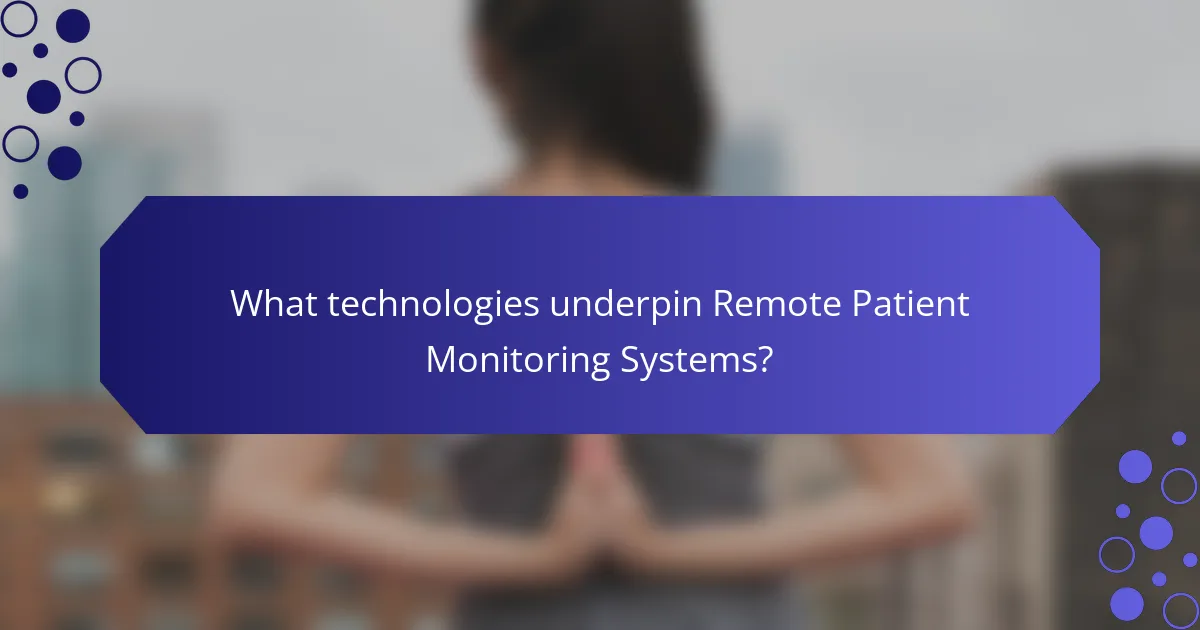
What technologies underpin Remote Patient Monitoring Systems?
Remote Patient Monitoring Systems utilize various technologies including wearable devices, mobile applications, and telehealth platforms. These technologies enable real-time data collection, patient monitoring, and communication between healthcare providers and patients. Wearable devices, such as smartwatches, track vital signs and activity levels, while mobile apps facilitate user engagement and data sharing. Telehealth platforms integrate these technologies, allowing for virtual consultations and continuous patient support. This combination enhances patient outcomes and engagement through timely interventions and personalized care.
How do wearable devices play a role in Remote Patient Monitoring?
Wearable devices enhance Remote Patient Monitoring by providing real-time health data, improving patient engagement, and enabling timely interventions. These devices, such as fitness trackers and smartwatches, collect vital signs and activity levels, facilitating continuous monitoring.
The integration of wearable technology in healthcare allows for immediate feedback, empowering patients to take an active role in their health management. For instance, data from wearables can alert healthcare providers to irregularities, ensuring prompt action when necessary.
Moreover, wearables contribute to a more personalized healthcare experience by tracking individual health metrics over time. This data can be analyzed to identify trends, tailor treatment plans, and improve overall health outcomes.
In summary, wearable devices are crucial in Remote Patient Monitoring, driving better health management and enhancing patient-provider communication.
What software platforms are commonly used in Remote Patient Monitoring?
Common software platforms used in Remote Patient Monitoring include Philips Healthcare, Medtronic Care Management Services, and BioTelemetry. These platforms offer features like real-time data tracking, patient engagement tools, and analytics. They enhance patient care by enabling continuous health monitoring and timely interventions.
Which data transmission technologies are essential for Remote Patient Monitoring?
Essential data transmission technologies for Remote Patient Monitoring include cellular networks, Wi-Fi, Bluetooth, and satellite communication. These technologies enable real-time data transfer, ensuring timely patient care and effective monitoring. Cellular networks provide extensive coverage, while Wi-Fi offers high-speed connections in localized settings. Bluetooth is ideal for short-range device communication, and satellite communication supports remote areas. Each technology plays a crucial role in enhancing patient engagement and ensuring reliable health data transmission.
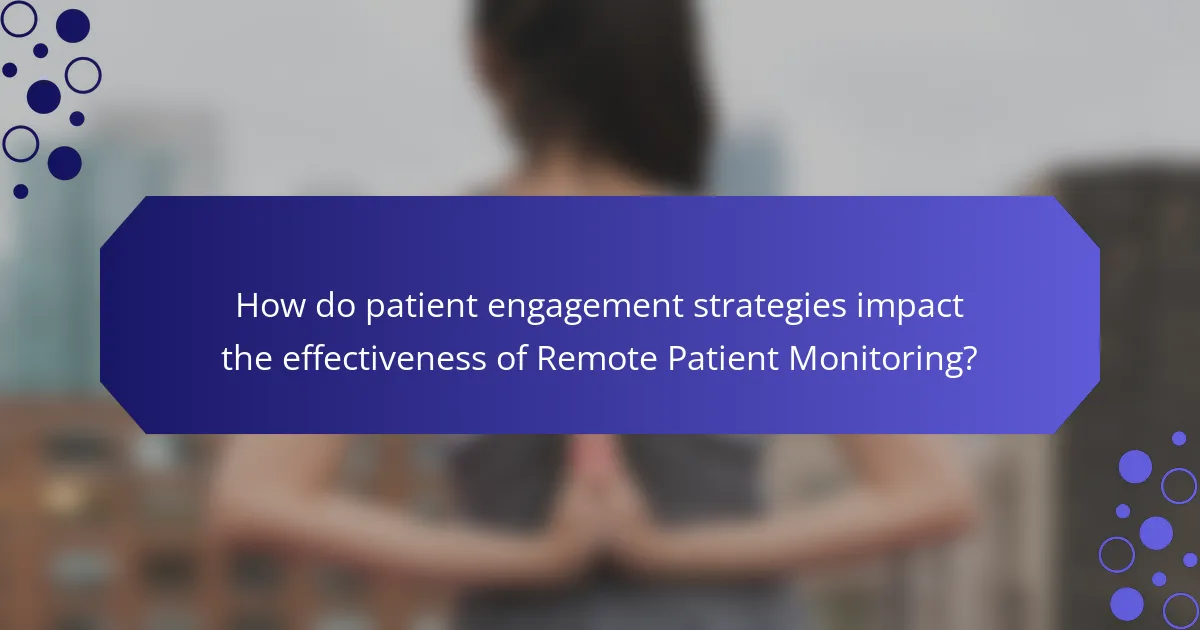
How do patient engagement strategies impact the effectiveness of Remote Patient Monitoring?
Patient engagement strategies significantly enhance the effectiveness of Remote Patient Monitoring by fostering adherence and improving health outcomes. Engaged patients are more likely to utilize the technology effectively, leading to timely interventions and better management of chronic conditions. Strategies like personalized communication, educational resources, and feedback mechanisms can increase patient motivation and satisfaction. As a result, these approaches not only boost compliance but also contribute to a more accurate and comprehensive understanding of patient health data, ultimately driving better clinical decisions.
What role does patient education play in Remote Patient Monitoring success?
Patient education is crucial for the success of Remote Patient Monitoring (RPM) systems. It empowers patients to understand their health conditions, enhances compliance with treatment plans, and fosters active participation in their care. Educated patients are more likely to use RPM technologies effectively, leading to improved health outcomes and reduced hospitalizations. Furthermore, effective education helps bridge the gap between technology and patient engagement, ensuring that patients can leverage RPM tools to monitor their health efficiently.
How can healthcare providers foster better communication with patients in Remote Patient Monitoring?
Healthcare providers can enhance communication with patients in Remote Patient Monitoring by utilizing technology and personalized engagement strategies. Regular updates through secure messaging platforms foster trust and transparency. Implementing video consultations allows for real-time interaction, addressing concerns promptly. Educational resources tailored to individual patient needs promote understanding and adherence to health plans. Encouraging feedback through surveys helps refine communication methods and improve patient satisfaction.
Which incentives can motivate patients to use Remote Patient Monitoring Systems?
Incentives that motivate patients to use Remote Patient Monitoring Systems include improved health outcomes, convenience, and financial rewards. Patients experience better management of chronic conditions, reducing hospital visits. The technology allows for real-time data sharing, enhancing patient engagement. Additionally, some healthcare plans offer financial incentives for consistent use, encouraging adherence to monitoring protocols.
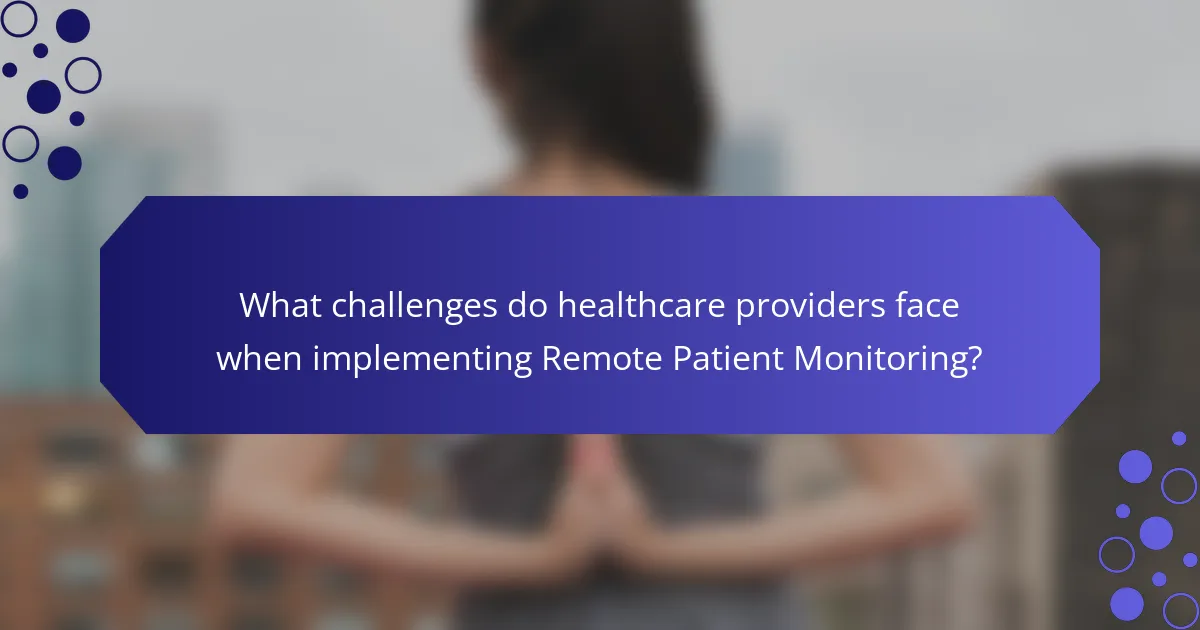
What challenges do healthcare providers face when implementing Remote Patient Monitoring?
Healthcare providers face several challenges when implementing Remote Patient Monitoring (RPM) systems. Key issues include data security concerns, integration with existing healthcare systems, and ensuring patient engagement.
Data security is paramount; providers must protect sensitive patient information from breaches. Integration challenges arise as RPM systems need to work seamlessly with electronic health records and other technologies. Additionally, maintaining patient engagement requires effective communication strategies and user-friendly interfaces to encourage consistent use.
Training healthcare staff on RPM technologies and addressing regulatory compliance also present significant hurdles. These challenges can hinder the successful adoption and effectiveness of RPM systems in improving patient care and outcomes.
How can data security and privacy concerns be addressed in Remote Patient Monitoring?
Data security and privacy concerns in remote patient monitoring can be addressed through robust encryption, regular audits, and patient education. Implementing end-to-end encryption ensures that patient data remains confidential during transmission. Regular audits identify vulnerabilities in the system, allowing for timely updates and fixes. Educating patients on data privacy practices empowers them to protect their information. Additionally, compliance with regulations like HIPAA enhances trust and security in remote monitoring systems.
What are the common technical issues encountered in Remote Patient Monitoring?
Common technical issues in Remote Patient Monitoring include connectivity problems, data accuracy concerns, device interoperability challenges, software integration issues, user interface difficulties, and cybersecurity threats. These issues can hinder effective patient engagement and diminish the overall benefits of monitoring systems. Addressing these challenges is crucial for improving patient outcomes and system reliability.
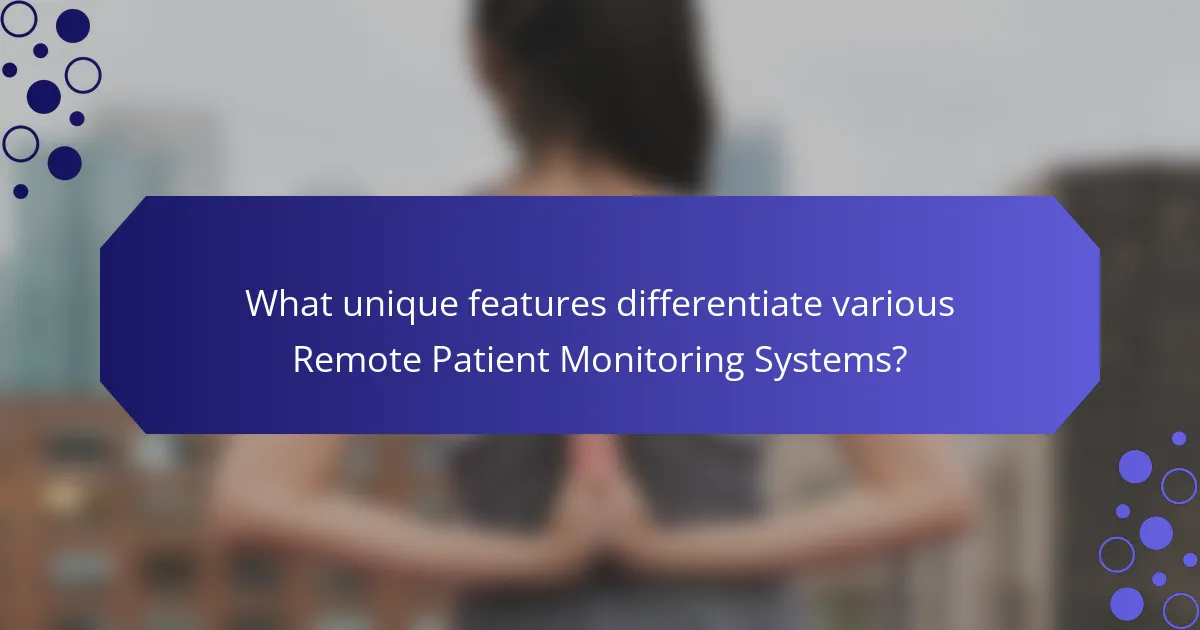
What unique features differentiate various Remote Patient Monitoring Systems?
Remote Patient Monitoring Systems vary significantly based on features such as data integration, user interface, and analytics capabilities. Key differentiators include real-time data transmission, interoperability with electronic health records, and customizable patient engagement tools. Some systems offer advanced predictive analytics, while others focus on ease of use for both patients and providers. These unique features enhance patient care and streamline healthcare processes.
How do customization options enhance user experience in Remote Patient Monitoring?
Customization options significantly enhance user experience in Remote Patient Monitoring by tailoring functionalities to individual needs. Personalized dashboards, alert settings, and report formats allow patients to engage with their health data meaningfully. This adaptability fosters higher satisfaction and adherence to monitoring protocols. As a result, users feel empowered, leading to improved health outcomes and more effective communication with healthcare providers.
What innovative features are emerging in Remote Patient Monitoring technology?
Innovative features in Remote Patient Monitoring technology include real-time data analytics, AI-driven predictive insights, and enhanced patient engagement tools. These advancements improve patient outcomes and streamline healthcare delivery. For instance, wearable devices now monitor vital signs continuously, sending alerts for any anomalies. Additionally, integrated telehealth platforms facilitate direct communication between patients and healthcare providers, enhancing support and adherence to treatment plans.

What are the best practices for optimizing Remote Patient Monitoring Systems?
To optimize Remote Patient Monitoring Systems, focus on user-friendly interfaces, data security, and seamless integration with existing healthcare systems. Prioritize patient engagement through personalized communication and regular feedback loops. Leverage advanced technologies like AI for data analysis and predictive analytics to enhance decision-making. Regularly update systems to incorporate feedback and adapt to evolving healthcare needs.
How can healthcare providers improve patient adherence to Remote Patient Monitoring?
Healthcare providers can improve patient adherence to Remote Patient Monitoring by enhancing communication, personalizing care plans, and utilizing technology effectively. Clear communication about the importance of monitoring fosters understanding and commitment. Personalization of care plans increases relevance, making patients more likely to engage. Additionally, leveraging user-friendly technology ensures patients can easily interact with monitoring systems, leading to better adherence.
What common mistakes should be avoided when implementing Remote Patient Monitoring?
Common mistakes to avoid when implementing Remote Patient Monitoring include insufficient training for healthcare staff, neglecting patient engagement, failing to ensure data security, and not integrating systems with existing workflows. These oversights can hinder the effectiveness of the monitoring system and compromise patient care. Proper training, proactive communication, robust security measures, and seamless integration are essential for successful implementation.
Which metrics should be tracked to evaluate the success of Remote Patient Monitoring initiatives?
Track metrics such as patient adherence, clinical outcomes, cost savings, patient satisfaction, and technology utilization to evaluate Remote Patient Monitoring initiatives. These metrics provide insights into the effectiveness and efficiency of the systems.
| Metric | Description |
|—————————-|————————————————–|
| Patient Adherence | Percentage of patients consistently using the system |
| Clinical Outcomes | Improvement in health conditions monitored remotely |
| Cost Savings | Reduction in healthcare costs associated with hospital visits |
| Patient Satisfaction | Feedback scores from patients regarding their experience |
| Technology Utilization | Frequency of device usage and engagement with the platform |
